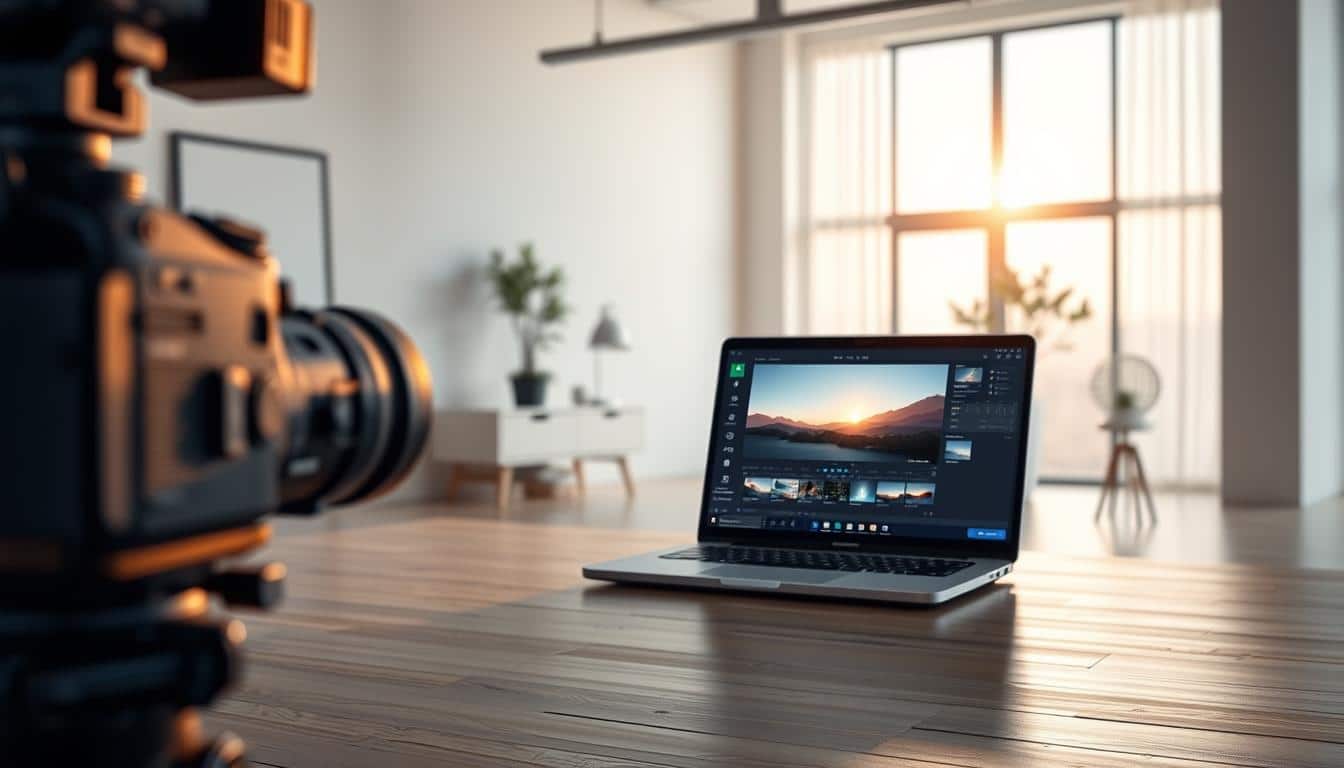Nowadays, having a professional virtual meeting space is key for remote work success. As more people work from home, it’s important to make virtual meetings better. This will help with productivity and keep everyone on the same page. We’ll look at what you need to make a good virtual space, and tackle the challenges of meeting online.
To beat distance challenges, we use top tech and create a welcoming space. This guide will show how to set meeting rules and ensure great video and audio. We aim to boost your virtual meetings’ effectiveness. We’ll share tips on improving team interaction and making communication smoother, which is vital for any modern team.
Anúncios
The Importance of a Professional Virtual Meeting Space
A professional virtual meeting space boosts professionalism and helps in effective communication. Microsoft research found that 66% of business leaders are updating offices for hybrid work. This shows how vital a professional setting is for smooth teamwork.
With more people working remotely, having a special meeting area shows you respect your team and clients. A good setup helps everyone work better together without distractions. Using advanced tech like projectors and video tools makes virtual meetings run smoothly.
Having the right sound and light is key for clear talks. Good internet is also necessary. Sadly, 1 in 10 work from home employees have poor internet. This means companies should invest in better internet and tools to book meeting rooms efficiently.
Leaders often meet for 23 hours a week. A pro meeting space not only looks good but keeps talented people from leaving. Studies show 64% of employees might leave if made to work in the office all the time. This points to the need for flexible work options.
Virtual meetings save money over meeting in person. New tech like digital whiteboards make work easier and more fun. But, video calls can limit creativity. This is why investing in a good virtual meeting space is important.
Unique Challenges of Virtual Meetings
Virtual meetings come with their own set of problems, often bigger than in-person ones. A major issue is participants feeling less connected in these discussions. This can cause a big drop in how much people engage and interact.
Zoom fatigue is a common result of virtual meetings. It’s the tiredness from too much screen time. This fatigue lowers productivity, making it crucial for teams to rethink how they meet.
Technical troubles like bad internet or broken hardware can interrupt virtual meetings. Being ready is crucial. Ways to prepare include testing gear before meetings and having backup plans ready.
Distractions at home or turning off cameras can lead to less involvement. Technologies like Krisp can remove background noise on platforms like Zoom, Google Meet, and Microsoft Teams. Adding interactive features, such as polls or breakout rooms, also increases engagement.
Time zone differences add challenges to planning meetings with people worldwide. Scheduling tools that find good times for everyone improve attendance. It’s also fair to change meeting times so everyone takes turns with less convenient slots.
Meetings often fail because the goals aren’t clear. Setting a detailed agenda beforehand ensures everyone knows what’s expected. This keeps the discussion on track.
Mastering the Art of Virtual Meetings
To have a great virtual meeting, follow some key rules to keep everyone engaged and communicating well. Using the right practices can make a big difference in how the meeting goes. Let’s look at these techniques for better virtual meetings.
Establishing Ground Rules for Engagement
Start with setting some basic rules to make the meeting respectful and fruitful. Think about these ideas:
- Encourage punctuality and commitment to meeting times.
- Suggest participants use video to reinforce their presence.
- Remind attendees to adhere to proper etiquette, such as muting when not speaking.
- Use a professional background or virtual backgrounds for a clean and distraction-free setting.
Crafting a Detailed Agenda
An agenda is key. It guides everyone on what will be discussed. Start by outlining the goals and arranging topics by their importance. This helps everyone understand the meeting’s aim and stay on track.
After the meeting, ask for feedback. This can help you improve future meetings.
Ensuring Active Participation
Making sure everyone gets involved is vital. You can:
- Interactive polling features to prompt discussions and gauge understanding.
- Lighthearted questions that involve participants personally.
- Using digital tools like interactive whiteboarding apps for visual presentations.
- Frequent breaks every 15-20 minutes to minimize mental fatigue.
With these methods, virtual meetings can become spaces where everyone contributes. This leads to better talks and decisions.
Creating a Professional Virtual Meeting Space
Designing a productive virtual meeting space requires focusing on key elements. A clean, professional background helps keep attention on the discussion. A well-chosen backdrop makes people feel more relaxed and involved.
Optimizing a meeting area isn’t just about how it looks. It’s about making spaces that make working together easy. Using templates and having clear goals make meetings run smoothly. This makes sure meetings achieve what they’re supposed to.
It’s important to make sure everyone can participate, especially since 45% of women say speaking up in virtual meetings is tough. It’s key to have fair ways to let everyone share their thoughts. Tools like Mural templates can make teamwork better, making sure all opinions are included.
Keeping track of decisions and important points helps keep everyone on the same page. Good audio and video quality is critical for clear communication. Platforms like Slack, Microsoft Teams, Zoom, and Google Meet offer great tools for working together smoothly.
Zoom’s interactive whiteboards make sharing ideas fun and engaging. Breakout rooms allow for deeper discussions in bigger meetings. Features like Slack’s customizable backgrounds and interactive tools enhance the virtual experience.
Optimizing Technology for Virtual Meetings
The right tech is key for great virtual meetings. Choosing a good platform is important for a smooth experience. Platforms like Zoom, Microsoft Teams, and Google Meet meet different needs. They make sure what you choose works well for your team’s goals and what everyone needs. Good sound and video are a must. Bad quality can make it hard to talk and make people less interested.
Selecting the Right Meeting Platform
When picking a platform, think about what everyone needs, especially if someone has trouble hearing. Microsoft Teams has cool tools like live words on screen. These tools make it easier for everyone to follow along. Having someone who pushes for these tools can really help make meetings better for everyone.
Video and Audio Quality Considerations
Good sound and video quality are super important. It’s a good idea to buy good mics and cameras. Experts like Pádraig Kitterick and Theodore Shomsky know a lot about making technology better for everyone. Plus, having rules for how to do virtual meetings can help. Using AI for instant translation and writing down what’s said can make meetings better. Then, people can focus more on the meeting instead of taking notes.
Lighting and Sound Setup for Virtual Meetings
How you set up lighting and sound can make or break your virtual meetings. Good lighting makes everything clear and looks professional. On the other hand, clear sound is key for easy talks. For lighting, avoid light from behind you and choose soft light to reduce shadows. This makes the video look better and everyone looks good on screen.
Best Practices for Lighting
Here are some tips to get your lighting right:
- Have the main light in front of you or to the side at a 45-degree angle to stop backlighting.
- Use diffused lights like lamp shades or softbox lights for a soft glow and fewer shadows.
- Choose lights close to 6000K for a bright day look or 2700K for a cozy feel.
- Use a two-point or three-point lighting setup for a more professional look. This includes a key light for main light, a fill light to reduce shadows, and a back light to add depth.
- Buy high-CRI lights, close to 100, for natural colors. Consider the Lume Cube Panel Mini or adjustable LEDs.
- Match your screen brightness with room lighting and use curtains for natural light control.
Choosing Quality Audio Equipment
Choosing the right audio gear is essential for good virtual meeting sound. Here’s what to do for high-quality audio:
- Choose USB mics like the Blue Snowball or Fifine for great sound and easy use.
- Get clearer sound with accessories like pop filters and shock mounts that cut down unwanted noise.
- Keep your space quiet. Use software to remove background noise for crystal-clear audio.

Leveraging Interactive Features for Engagement
Adding interactive features to virtual meetings is key. They keep attention high and boost teamwork. With tools like screen sharing and breakout rooms, regular online meetings become engaging spaces. This encourages everyone to join in.
Screen Sharing and Visual Aids
Screen sharing helps explain complex ideas simply. It keeps everyone focused. Using visual aids improves understanding. Adding annotation tools lets participants give feedback instantly. Live polls are great for seeing what everyone thinks, making the meeting more interactive and fun.
Utilizing Breakout Rooms for Collaborative Discussions
Breakout rooms are perfect for small group chats. They help with brainstorming and solving problems together. This approach makes meetings more friendly and makes sure everyone’s voice is heard. Keeping software updated means everyone has the best tools for engaging in these meetings.
Cultivating Connection and Company Culture Remotely
To have a strong team from afar, it’s key to make sure everyone feels connected. By holding virtual team-building activities during meetings, companies can make teams closer, boost spirit, and make everyone feel part of the group. Fun online team activities help improve how the team works together.
Incorporating Team-Building Exercises
Virtual team-building doesn’t just make everyone get along better, it also lets team members get to know each other personally. With things like trivia, virtual escape rooms, and team projects, team spirit goes up. Participating in these fun things shows off everyone’s talents, helping them work together and be creative. The metaverse can even offer 3D spaces for these, making interactions even cooler.
Encouraging Casual Interactions
Chatting informally really helps team spirit. Setting up special channels for chatting about non-work stuff or having virtual coffee hangs can lead to easy talks. It’s like the random conversations you’d have in a normal office. These small talks help teammates bond. By doing this, remote teams become tighter and more welcoming.
Streamlining Follow-Up Procedures After Meetings
Effective follow-up actions after virtual meetings ensure clarity and keep everyone accountable. It’s crucial that all meeting participants stay updated on the key points and tasks they need to tackle. Sharing the meeting notes quickly is the first step to setting up successful next steps.
Sharing Meeting Notes Promptly
Right after the meeting, it’s important to share the notes quickly. This makes sure everyone is on the same page about what was decided and what they need to do. AI tools can help create detailed summaries quickly. Tools like Google Docs or OneNote let everyone edit and update in real time, helping track the progress on tasks.
Setting Clear Deadlines and Next Steps
Setting clear deadlines helps keep the team moving forward. When tasks are specific and measurable, everyone knows what they need to do. Using SMART goals makes these tasks clearer. Checking progress with tools like JIRA keeps everyone focused and reminds them to complete their tasks.
Conclusion
In today’s fast-changing work scene, making virtual meetings better is very important. Setting up a professional space for meetings helps companies deal with the challenges of working together from different places. By using a clear plan, choosing the right technology, and using tools that help people interact, companies can have meetings that are both fun and effective. This makes teams stronger.
Using smart technology, like what you find in Zoom and Microsoft Teams, is key to good virtual meetings. These platforms improve how we hear and see each other and let us share screens and make changes together in real-time. Keeping meetings safe with passwords and secure recording storage is also crucial. This keeps everyone’s trust.
As companies figure out how to work now and in the future, mixing in-person and online meetings will be important. New technologies and features that make meetings more interesting will help a lot. By focusing on these approaches, teams can do well in the flexible work environment of today. This ensures everyone can work together well and enjoy it.
FAQ
What is a professional virtual meeting space?
Why are virtual meeting spaces important in a remote work environment?
What challenges do virtual meetings present compared to in-person gatherings?
How can I establish ground rules for effective virtual meetings?
Why is crafting a detailed agenda important for virtual meetings?
What are some effective ways to encourage active participation in virtual meetings?
How should I design my professional virtual meeting space?
What technologies should I prioritize for effective virtual meetings?
What are the best practices for lighting in virtual meetings?
Why is audio quality important in virtual meetings?
How do interactive features enhance engagement during virtual meetings?
How can team-building exercises be incorporated into virtual meetings?
What follow-up procedures should I establish after virtual meetings?
Conteúdo criado com auxílio de Inteligência Artificial



